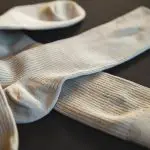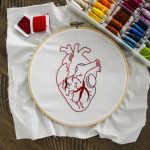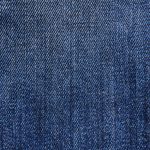When you start exploring machine embroidery, it's important to grasp the fundamentals that can make or break your projects. You'll need to understand the various types of embroidery, the essential tools at your disposal, and the techniques that ensure success. Knowing how to choose the right stabilizers and mastering thread tension can elevate your work significantly. But what common pitfalls should you be aware of, and how can you truly enhance your embroidery skills? The answers might surprise you.
Table of Contents
Key Takeaways
- Familiarize yourself with different types of machine embroidery, including free-motion and computerized methods, to choose the right one for your project.
- Understand essential tools like the embroidery machine, quality threads, stabilizers, and hoop sizes for successful stitching.
- Master techniques such as stabilizer selection, thread tension adjustment, and needle matching to enhance stitch quality and prevent mistakes.
- Avoid common pitfalls like neglecting test stitches, improper hooping, and using incorrect needle types to ensure a smooth embroidery process.
Understanding Machine Embroidery Basics
To master machine embroidery, you need to grasp its fundamental concepts and techniques.
Start by familiarizing yourself with the various types of machine embroidery, such as free-motion and computerized embroidery. Each method has its unique charm and application. Understanding the difference helps you choose the right approach for your projects.
Next, learn about stitch types and their functions. You'll encounter satin stitches, fill stitches, and running stitches, each offering different textures and effects. Knowing when to use each stitch is crucial for achieving the desired look and durability in your embroidery.
Don't overlook the importance of design elements. Whether you're creating your own designs or using pre-made ones, understanding how to manipulate them will elevate your work. Pay attention to factors like density, color, and placement, as these impact the final outcome.
Essential Tools and Equipment
Having the right tools and equipment is crucial for achieving excellent results in machine embroidery. Start with a reliable embroidery machine, as it's the heart of your setup. Choose one with various stitching options and features that suit your project needs.
Don't forget about quality embroidery threads; they come in different materials, including cotton, polyester, and rayon. Each type offers unique finishes and durability, so pick what works best for you.
Next, invest in stabilizers. These are essential for preventing fabric distortion during the stitching process. The type of stabilizer you choose—tear-away, cut-away, or water-soluble—depends on your fabric and design.
You'll also need hoops to hold your fabric taut while you work. Make sure to select the appropriate hoop size for your designs.
Scissors and seam rippers are handy for trimming threads and correcting mistakes, which will inevitably happen.
Techniques for Successful Embroidery
Mastering various techniques can significantly elevate the quality of your machine embroidery projects. To get started, focus on the basics like stabilizers, thread tension, and needle selection. Each of these elements plays a crucial role in achieving crisp and clean designs.
Here's a table to help you understand different techniques and their purposes:
| Technique | Purpose |
|---|---|
| Stabilizers | Provides support to prevent fabric puckering |
| Thread Tension | Ensures even stitching and prevents thread breakage |
| Needle Selection | Matches the needle type with fabric for optimal results |
| Embroidery Speed | Adjusts the speed for complex designs to avoid mistakes |
Experiment with different stabilizers for various fabrics to find what works best for you. Don't forget to adjust your thread tension based on the thread type and fabric weight. Choosing the right needle is essential; a universal needle might work for most projects, but specialized needles are better for specific fabrics. By honing these techniques, you'll set yourself up for success in your machine embroidery endeavors.
Common Mistakes to Avoid
One of the most common mistakes you can make in machine embroidery is neglecting to choose the right stabilizer for your fabric, which can lead to poor stitch quality and unwanted puckering. Always match the stabilizer to your fabric type and design complexity.
Another mistake isn't testing your design before committing it to your final project. It's crucial to run a test stitch on a scrap piece of the same fabric to ensure everything looks right. Skipping this step can result in costly errors.
You might also forget to properly hoop your fabric, which can cause misalignment and distortion. Make sure your fabric is taut but not overly stretched in the hoop.
Additionally, using the wrong needle can ruin your project. Each needle has a specific purpose, so check that you're using the appropriate one for your fabric and thread.
Tips for Enhancing Your Projects
Enhancing your machine embroidery projects starts with experimenting with different thread types and colors to achieve unique textures and vibrant designs. Don't be afraid to mix cotton, polyester, and metallic threads; each offers its own charm. Consider using variegated threads for added depth and interest.
Next, pay attention to your stabilizers. Choosing the right stabilizer can make all the difference in the final result. For lightweight fabrics, use a tear-away or cut-away stabilizer to maintain structure without adding bulk. For stretchy materials, opt for a water-soluble stabilizer to prevent distortion.
Another tip is to adjust your tension settings. A little tweaking can help your stitches lay perfectly flat and enhance overall appearance. Test your settings on scrap fabric first to find the sweet spot.
Lastly, don't overlook the power of layering. Combine different designs or stitch techniques to create a multi-dimensional effect. Adding embellishments like beads or sequins can also elevate your project to the next level.
Frequently Asked Questions
What Fabrics Are Best for Machine Embroidery Projects?
For machine embroidery projects, you'll want to choose fabrics like cotton, linen, or polyester blends. These materials hold stitches well and resist fraying, ensuring your designs look sharp and professional after finishing.
How Do I Choose the Right Embroidery Thread?
To choose the right embroidery thread, consider the fabric type and project purpose. Match thread weight to your needle, and decide between cotton or polyester based on desired sheen and durability. Test samples to ensure compatibility.
Can I Machine Embroider on Knit Fabrics?
Yes, you can machine embroider on knit fabrics! Just use a stabilizer to prevent stretching and select the right needle type. This ensures your designs look crisp and professional while maintaining the fabric's flexibility.
What Is the Best Way to Stabilize Delicate Fabrics?
To stabilize delicate fabrics, you should use lightweight tear-away or water-soluble stabilizers. Pin or baste them securely, and test a scrap piece first to ensure the fabric maintains its integrity during embroidery.
How Do I Maintain My Embroidery Machine?
To maintain your embroidery machine, regularly clean it, oil moving parts, and check the tension. Replace needles as needed, keep the workspace dust-free, and refer to the manual for specific maintenance guidelines to ensure optimal performance.







